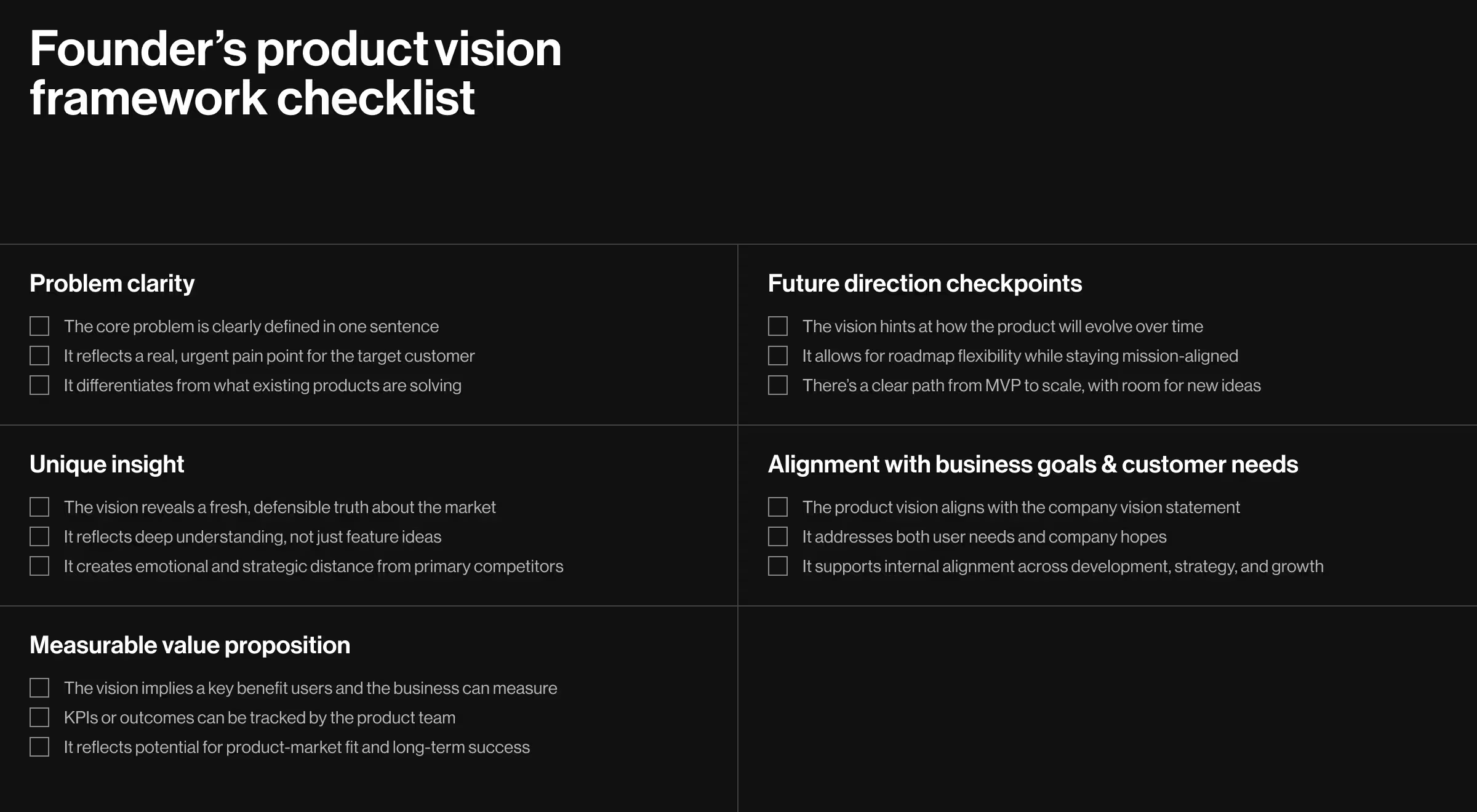We're here because your product vision isn't big enough.
Until it gives customers a reason to care, staff a reason to stay, and the market a reason to notice, your growth will stall.
Raise the bar, then build toward it. But in ultra‑fast q-commerce you don’t have much time to prove that your idea can turn into repeat revenue. Ninja Delivery nailed that window with a 10‑minute‑or‑less promise and raised $2.8 million before its first dark store even opened.
A razor‑sharp product vision did the selling long before any roadmap or feature doc.
Key takeaways
- Product vision ≠ mission, roadmap, or backlog. It is the north‑star promise both investors and teams can recite in one breath.
- A clear product vision statement follows a simple arc: Problem → Insight → Future State → Value.
- Vision must evolve at every stage (MVP, traction, pivot, scale), yet stay recognizable.
- Tying vision to rituals keeps product managers, product owners, and development teams aligned and customer‑focused.
What is a product vision?
A product vision is a concise description of the positive future state your product will create for its target customer.
NN/g frames it as a pledge to “organize the world's information and make it universally accessible and useful.” That differs from a company vision, which speaks to the whole business, and a product roadmap, which lists the development process.
“What is a product vision? It’s a north‑star statement that helps every product team decide why they build each feature before figuring out what or when.”
{{Anna Demianenko}}
Vision vs. mission, strategy, and roadmap
Clear separation prevents “feature drift” and ensures both the development team and stakeholders move in the same direction:
🔎 If you need a step‑by‑step playbook for turning a high‑level vision into a shipping roadmap, read our product strategy framework guide!
Crafting a product vision statement
Use this four‑step product vision framework to create a statement investors call compelling:
- Problem — Why status‑quo hurts.
- Insight — The hidden truth you found.
- Future state — Life after you win.
- Value — The key benefits customers and the business gain.
✅ Pro tip for product owners who contribute directly to vision work:
Draft a boardroom, all‑hands, and tweet‑length version; if the shortest loses meaning, your statement isn’t inspiring enough.
Top 10 real‑world product vision examples
- Google: “Provide access to the world's information with one click.”
- Instagram: “Capture and share the world's moments.”
- Uber: “Evolve the way the world moves by connecting riders to drivers through apps.”
- LinkedIn: “Create economic opportunity for every member of the global workforce.”
- Amazon: “Be Earth’s most customer‑centric company, where customers can find and discover anything they might want to buy online.”
- Fender: “Accompany each player at every stage with products and experiences that fuel musical expression.”
- GitLab: “Offer DevOps teams a build agent that works seamlessly on future market‑leading platforms.”
- Tesco: “Provide a single source of decision-making for loss prevention across any channel or market.”
- Asana: “Help teams navigate their mission with up‑to‑date information about the road ahead.”
- Zoom: “Deliver an AI‑first work platform for human connection.”
You can use these as product vision examples to stress‑test whether yours is equally bold, customer‑focused, and memorable.
Founder’s product vision framework
Every product vision statement starts with inspiration but it must hold up to strategic scrutiny. Use this checklist to pressure-test whether your vision statement concisely captures not just what your product is, but why it matters and how it wins.
📋 Copy this into your product vision board, roadmap, or strategy doc. Revisit quarterly.

Evolving vision: MVP → traction → pivot → scale
- MVP: Articulate one customer‑focused outcome.
- Traction: Verify unit economics and refine product strategy.
- Pivot: Keep the vision headline; update scope as creating a product line or new ideas emerge.
- Scale: Roll sub‑visions into one shared vision for the global workforce that uses your product.
🔎 For a data‑heavy SaaS example of a vision that matured from Series B to acquisition, see our Accern Rhea case study!
McKinsey notes successful companies “anchor growth in a core vision, iterating go‑to‑market.” In practice, that means treating the vision as the first checkpoint at every funding round. If a feature, market, or metric can’t map back to the headline promise, it gets cut or recast.
Communicating vision to teams & investors
An inspiring product vision is lived. The best successful companies don’t treat the vision statement as a slide deck ornament. They build rituals that reinforce it, align execution to it, and use it to attract funding, talent, and belief. Both the product vision and company vision statement must resonate from the C-suite to the sprint retrospective.

Here’s how to embed your compelling product vision into the rhythm of your development process and investor communications.
Internal team rituals that reinforce vision
- Monthly all-hands
The CEO or product manager retells the vision statement using fresh user stories, outcomes, or data. This ensures the product team sees the connection between day-to-day work and long-term ambition. Tie each story back to the key benefit and target customer the product serves.
Example: “Last month, Maya in Lagos got groceries in 9 minutes using our new one-click reorder. That’s our ‘10 minutes, every time’ vision delivered.” - Sprint kick-offs
Every sprint begins with a brief from product owners that maps backlog items directly to the product vision board. Even if the ticket is tactical — a filter, a new notification — teams must understand how it supports the overarching product strategy and contributes to achieve product success. - Design critiques & reviews
Use the product vision as a filter. Does this feature reflect the value proposition? Will it reinforce the future state the product aims to create? This reduces vision-drift and ensures consistency across the UX. - Quarterly vision syncs
High-performing teams revisit their product vision template quarterly. Ask: has the target customer evolved? Has new market data reshaped our insight? Are we still addressing the right pain points with our current product features?
Vision as a strategic investor tool
Your vision statement is your first impression in every fundraising pitch. Before any numbers or tech specs, investors want to know:
Why does this product exist? What future does it create? And why are you the one to build it?
- Pitch decks
Make your product vision statement Slide #1. It sets the tone and narrative arc. Follow it with proof points: product-market fit, velocity, growth, or use of project management tools to align teams efficiently. - Investor updates
Frame progress through the lens of your shared vision:
e.g. “We hit 90% delivery under 10 minutes this quarter — our original vision in motion.”
or “Expansion into Vancouver aligns with our future direction to be the world’s leading producers of instant commerce experiences.” - Hiring and onboarding
A clear product vision attracts aligned talent. Integrate it into job descriptions, onboarding decks, and team OKRs. Your best engineers, designers, and analysts join not for the current feature set but for the beneficial change the product promises.
From slide to soul: make the vision real
To create a successful product, the product management and development team must treat the vision statement as a living artifact.
Whether you’re creating a product from scratch or evolving an existing product, ensure the company hopes, values, and overarching long-term mission are consistently visible in:
- Product documentation
- Onboarding flows
- UI copy and brand voice
- Quarterly business reviews
- Cross-functional retrospectives
📌 Remember: If your development team, salespeople, or customer success reps can’t summarize your vision in one sentence — it’s not the right vision yet. A truly beautiful vision aligns product category, product roadmap, and customer emotion in a single breath.
Living product vision document checklist
Ask these five questions at each quarterly review:
- Can every development team member quote the vision?
- Do key KPIs map back to it?
- Has the target customer or pain point shifted?
- Did market data invalidate our unique insight?
- Is the vision visible in onboarding, marketing, and investor decks?
Two “no” answers? — Time for a vision sync!
Case slice: Ninja Delivery
Ninja Delivery is a Waterloo‑ and Toronto‑based q‑commerce startup that set an audacious goal: groceries, snacks, and household goods at the customer’s door in 10 minutes or less.

To hit that benchmark and stand out in an increasingly crowded market, they needed an MVP that felt effortless for both shoppers and couriers, yet persuasive enough to secure seed funding before the first dark store opened.
Vision‑driven approach
Lazarev.agency, an AI product design agency, anchored every design decision to the north‑star statement “10 minutes, every time.” That meant:
- One design system, three user journeys. A unified UI spanned the customer app, courier app, and marketing site, lowering friction and building instant trust.
- Ordering experience that converts. Large thumb‑zone targets, progressive disclosure, and micro‑animations kept first‑time shoppers moving to checkout without cognitive overload.
- Courier workflow built for speed. Night‑friendly contrast, a persistent “job card,” and color‑coded status chips kept riders on pace with the 10‑minute SLA, even in motion and outdoor glare.
- Landing page clarity at a single glance. A bold promise above the fold, brand‑yellow CTAs, and flat‑design content blocks explained the service before users could scroll.
12‑month impact
By binding every feature, screen, and logistics tweak to a single headline promise, Ninja Delivery proved that a customer‑focused product vision can guide rapid iteration without diluting ambition.
Their achievements over the year:
- Seed investment: $2.8 M raised
- Weekly growth: 20%+ WoW during summer 2021
- Orders fulfilled: 30 K+ total deliveries
- Expansion: 3 dark stores launched
Is your product vision strong enough to scale?
A compelling product vision guides every product decision, aligns the development team, and sells the future to users, investors, and teammates alike. Use this product vision rubric to self-assess whether your vision statement concisely captures your product's mission, strategic edge, and growth potential.
Grab a notepad, or plug these into your product vision board. If you’re not scoring high across the board, it may be time to revise with your product team, product manager, or core stakeholders involved.
Product vision diagnostic checklist
💡 Pro tip: A beautiful vision is more than words. It drives execution. If your score dips below 40, revisit your product vision statement template and iterate with your product management team. Use inspiration from real world vision statements like “Provide access to the world’s information” or “Create economic opportunity for the world’s professionals,” and tailor it to your product category, future direction, and primary differentiation.
Turn vision into traction
A crisp, evolving product vision, communicated through a structured product roadmap and owned by committed product managers, wins capital, talent, and market share.
Need help articulating yours or validating that it still sells? Let’s talk!





























.webp)



















